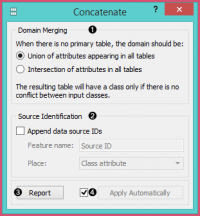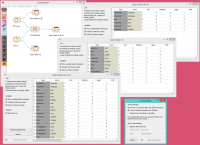Difference between revisions of "Orange: Concatenate"
Onnowpurbo (talk | contribs) |
Onnowpurbo (talk | contribs) |
||
| Line 2: | Line 2: | ||
| − | + | Menggabungkan data dari berbagai sumber. | |
| − | + | ==Input== | |
| − | + | Primary Data: data set that defines the attribute set | |
| + | Additional Data: additional data set | ||
| − | + | ==Output== | |
| − | + | Data: concatenated data | |
| − | + | Widget ini menggabungkan beberapa set instance (dataset). Penggabungan adalah "vertikal", dalam arti bahwa dua set 10 dan 5 instance menghasilkan set baru 15 instance. | |
| − | |||
| − | |||
[[File:Concatenate-stamped.png|center|200px|thumb]] | [[File:Concatenate-stamped.png|center|200px|thumb]] | ||
| − | + | * Set the attribute merging method. | |
| − | + | * Add the identification of source data sets to the output data set. | |
| − | + | * Produce a report. | |
| − | + | * If Apply automatically is ticked, changes are communicated automatically. Otherwise, click Apply. | |
| − | |||
| − | + | Jika salah satu tabel terhubung ke widget sebagai tabel utama, tabel yang dihasilkan akan berisi atributnya sendiri. Jika tidak ada tabel utama, atribut dapat berupa gabungan dari semua atribut yang muncul dalam tabel yang ditentukan sebagai Tabel Tambahan, atau persimpangan mereka, yaitu daftar atribut yang umum untuk semua tabel yang terhubung. | |
| − | + | ==Contoh== | |
| − | |||
As shown below, the widget can be used for merging data from two separate files. Let’s say we have two data sets with the same attributes, one containing instances from the first experiment and the other instances from the second experiment and we wish to join the two data tables together. We use the Concatenate widget to merge the data sets by attributes (appending new rows under existing attributes). | As shown below, the widget can be used for merging data from two separate files. Let’s say we have two data sets with the same attributes, one containing instances from the first experiment and the other instances from the second experiment and we wish to join the two data tables together. We use the Concatenate widget to merge the data sets by attributes (appending new rows under existing attributes). | ||
Revision as of 12:03, 27 January 2020
Sumber: https://docs.biolab.si//3/visual-programming/widgets/data/concatenate.html
Menggabungkan data dari berbagai sumber.
Input
Primary Data: data set that defines the attribute set Additional Data: additional data set
Output
Data: concatenated data
Widget ini menggabungkan beberapa set instance (dataset). Penggabungan adalah "vertikal", dalam arti bahwa dua set 10 dan 5 instance menghasilkan set baru 15 instance.
- Set the attribute merging method.
- Add the identification of source data sets to the output data set.
- Produce a report.
- If Apply automatically is ticked, changes are communicated automatically. Otherwise, click Apply.
Jika salah satu tabel terhubung ke widget sebagai tabel utama, tabel yang dihasilkan akan berisi atributnya sendiri. Jika tidak ada tabel utama, atribut dapat berupa gabungan dari semua atribut yang muncul dalam tabel yang ditentukan sebagai Tabel Tambahan, atau persimpangan mereka, yaitu daftar atribut yang umum untuk semua tabel yang terhubung.
Contoh
As shown below, the widget can be used for merging data from two separate files. Let’s say we have two data sets with the same attributes, one containing instances from the first experiment and the other instances from the second experiment and we wish to join the two data tables together. We use the Concatenate widget to merge the data sets by attributes (appending new rows under existing attributes).
Below, we used a modified Zoo data set. In the first File widget, we loaded only the animals beginning with the letters A and B and in the second one only the animals beginning with the letter C. Upon concatenation, we observe the new data in the Data Table widget, where we see the complete table with animals from A to C.

